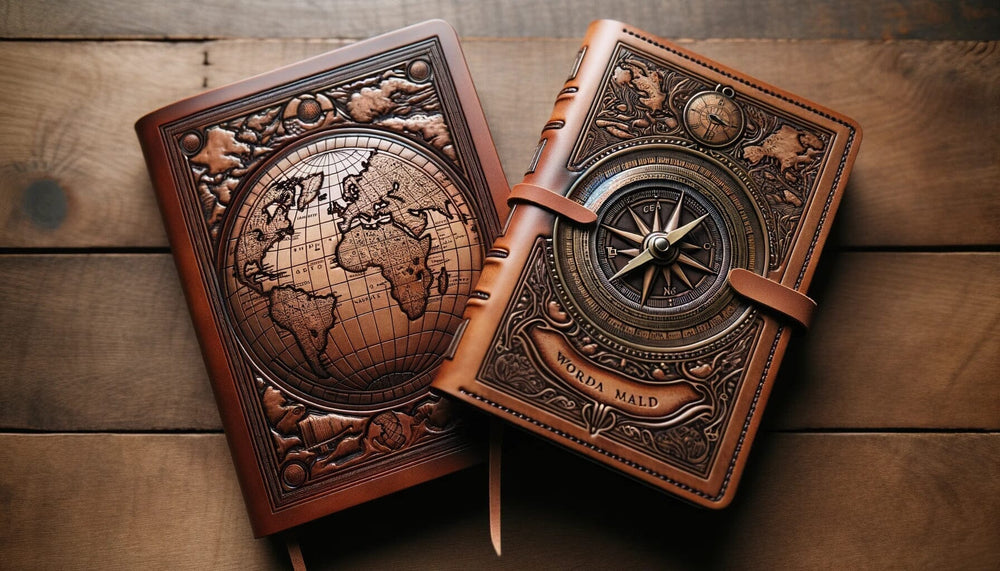
Embossed vs. Engraved Leather: The Artistic Duel Unveiled
Reading Time: about
In the vast realm of leather craftsmanship, two techniques have consistently stood out, captivating both artisans and enthusiasts: embossing and engraving. These age-old methods, steeped in tradition and refined over generations, breathe life into leather, transforming ordinary pieces into tactile masterpieces.
Each technique, with its unique approach, offers a different perspective on design, texture, and aesthetics. But what truly sets them apart? How has history shaped their evolution? And more importantly, how do they influence today's fashion and design landscapes?
Dive into our comprehensive guide as we unravel the intricacies of embossed vs. engraved leather, offering insights and revelations that might just reshape your perspective on leather products and their timeless allure.
I. Understanding Leather Embossing
Leather embossing is a fascinating world that I've delved into deeply. Let's explore it together.
1. What is Leather Embossing?
Leather embossing, in its essence, is the art of creating raised designs on leather surfaces. The process involves using a specialized die set that presses a specific design into the leather material. When I compare it to engraving, the primary distinction becomes clear: while engraving involves removing material to create a design, embossing raises the leather's surface to form a design. This results in a tactile, three-dimensional pattern that you can not only see but also feel.
2. Benefits of Embossed Leather
When we talk about embossed leather, several advantages come to mind:
- Aesthetic Appeal and Unique Designs: Embossed leather stands out. It adds a touch of sophistication and elegance to any item, making it instantly more attractive.
- Increased Durability and Wear Resistance: One might think that embossing weakens the leather, but in reality, the process can enhance its durability. The raised designs can act as a buffer, offering an added layer of protection against wear and tear.
- Versatility in Customization: The beauty of embossing is that it allows for a wide range of designs, from intricate patterns to simple logos.
- High Visibility of Raised Designs: The raised nature of embossed designs ensures they catch the light differently, making them more noticeable.
- Resilience in Harsh Environments: Embossed designs, due to their raised nature, are less prone to fading or wearing out, especially when exposed to harsh conditions.
3. Limitations of Embossing
However, like all things, embossing has its limitations:
- Need for Different Dies for Varied Designs: If you're looking to emboss multiple designs, you'll need a separate die for each, which can be cumbersome and costly.
- Complexity in Creating Intricate Designs: While embossing can handle a variety of designs, extremely intricate patterns might not always come out as crisply as one would hope.
4. Popular Uses of Embossed Leather
Embossed leather has found its way into various products that we use daily:
- Fashion: Think of those stylish bags, belts, and shoes you've seen in high-end stores. The chances are that some of them sported embossed designs.
- Home Decor: From luxurious furniture to chic upholstery, embossed leather adds a touch of class to any living space.
- Accessories: Wallets, book covers, and even some tech accessories have embraced the charm of embossed leather.
- Business and Events: Business cards, leather belts, and even wedding invitations have been elevated with the touch of embossing.
Leather embossing is a versatile and elegant technique that has enhanced the world of leather goods. Whether you're considering embossed leather for a personal project or a business venture, understanding its benefits and limitations will undoubtedly guide your decision.
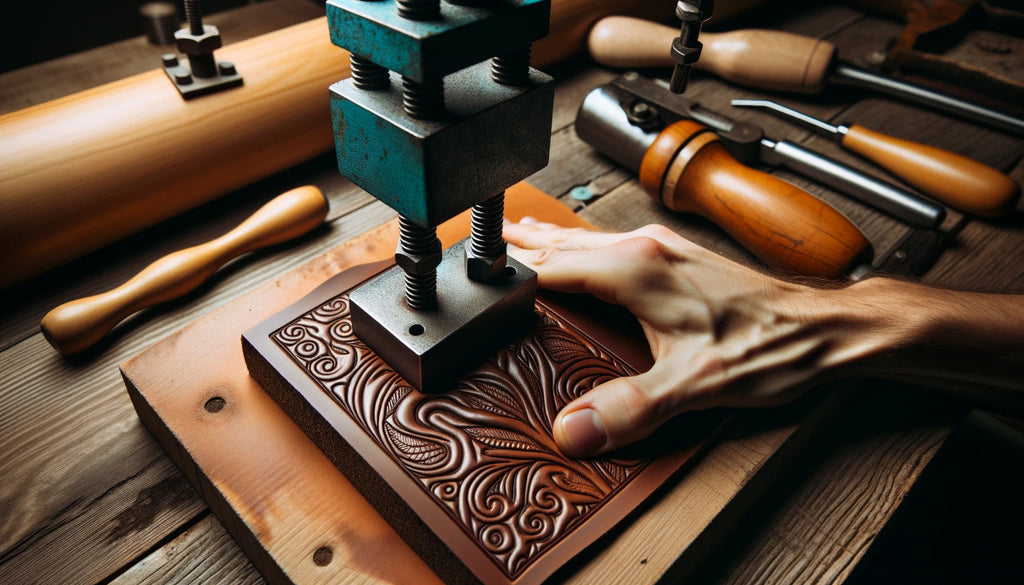
II. Delving into Leather Engraving
When we talk about leather craftsmanship, engraving stands out as a technique that has been cherished for centuries. But what exactly is leather engraving, and how does it differ from other methods like embossing?
1. What is Leather Engraving?
Leather engraving is an art form where designs are etched onto the leather's surface. Unlike embossing, which raises the leather's surface, engraving involves removing material to create a design.
Techniques in Leather Engraving:
- Laser Engraving: This modern method uses laser beams to burn designs onto the leather. It's precise, consistent, and perfect for intricate patterns.
- Hand Engraving: The traditional method where craftsmen use tools to manually carve designs. It's time-consuming but offers a personal touch.
- Rotary Engraving: Machines with rotating tools are used to etch designs. It's faster than hand engraving but not as precise as laser engraving.
The essence of engraving lies in its precision. By removing material, we can achieve detailed and lasting designs that truly stand out.
2. Advantages of Engraved Leather
Precision and Intricate Designs: One of the standout benefits of engraving is the level of detail it offers. Whether it's a complex logo or a delicate pattern, engraving captures it all.
Long-lasting Imprints: Due to the recessed designs, engraved patterns are less likely to wear off, ensuring they remain visible for years.
Personalization and Bespoke Creations: From monograms to custom artwork, engraving allows for personalized leather items that resonate with individuality.
Resilience Against Wear and Tear: Engraved designs, being etched into the leather, are more resistant to external factors, ensuring longevity.
3. Drawbacks of Engraving
While engraving offers numerous benefits, it's essential to be aware of its limitations.
Time-Consuming Process: Especially when done by hand, engraving can be a lengthy process, particularly for large projects.
Potential for Higher Costs: Given the expertise and equipment required, engraving might be pricier than other methods like embossing.
4. Common Applications of Engraved Leather
Personalized Gifts: Items like name tags and keychains become memorable keepsakes when engraved.
Artistic Creations: Wall art, sculptures, and other decorative pieces come alive with engraved designs.
Specialty Items: Custom journals, heirlooms, and other unique items often feature engraved elements, adding a touch of sophistication.
While leather engraving has its set of challenges, the results are undeniably worth it. As we explore the world of leather craftsmanship, it's techniques like engraving that remind us of the beauty and intricacy this material offers. Whether you're considering a personalized gift or a bespoke leather item, engraving might just be the perfect choice for you.
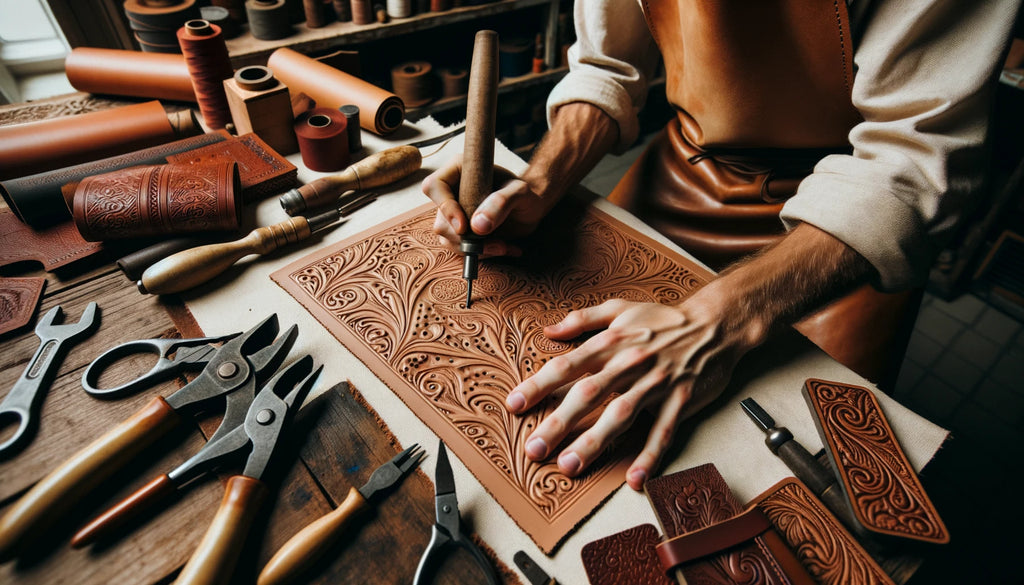
III. Embossed vs. Engraved Leather: Key Differences
When diving into the world of leather craftsmanship, it's essential to understand the nuances that set different techniques apart. Two such methods that often come up in discussions are embossing and engraving. While they might seem similar at first glance, they have distinct characteristics that cater to varied needs and preferences. Let's delve deeper into these differences.
1. Process and Techniques
Embossing: At its core, embossing is about giving life to the leather by raising its surface. When I think of embossing, I visualize a craftsman using a die or stamp to press into the leather, creating a raised design. This technique is particularly popular for adding decorative patterns or logos to leather goods, giving them a tactile and visually appealing finish.
Engraving: On the other hand, engraving is a more intricate process. It involves either cutting or etching directly into the leather's surface. Whether you're using traditional tools or modern laser equipment, engraving offers a level of detail and precision that's hard to achieve with other methods. It's like carving your signature into the leather, ensuring it stands the test of time.
2. Durability and Longevity
When we talk about the lifespan of embossed or engraved leather products, several factors come into play. Embossed designs, due to their raised nature, might show signs of wear over time, especially if they're frequently rubbed or brushed against. However, with proper care, they can remain prominent for years.
Engraved designs, being recessed, have a natural shield against external wear and tear. They're less likely to fade, making them a preferred choice for items that undergo frequent use. Regardless of the method, regular maintenance, like cleaning and conditioning, can significantly extend the life of your leather goods.
3. Cost Implications
When considering the financial aspect, both embossing and engraving come with their own set of considerations. The price range for both methods can vary based on several factors. For instance, the complexity of the design, the size of the project, and the quality of the leather chosen can all influence the final cost. While embossing might be more cost-effective for larger batches, engraving, especially detailed designs, might come with a higher price tag due to the precision and time involved.
4. Speed and Efficiency
In the realm of efficiency, embossing generally takes the lead. It's a quicker method, especially when dealing with larger quantities. So, if you're on a tight schedule, embossing might be the way to go.
However, if detail and intricacy are what you're after, engraving is unparalleled. While it might be more time-consuming, the results are often worth the wait. The depth and precision offered by engraving can truly elevate the aesthetics of any leather product.
Whether you opt for embossing or engraving largely depends on your project's needs and desired outcome. Both methods have their merits, and understanding these differences can help you make an informed choice. Remember, the beauty of leather lies in its versatility, and with the right technique, you can create pieces that are not only functional but also timeless in their appeal.
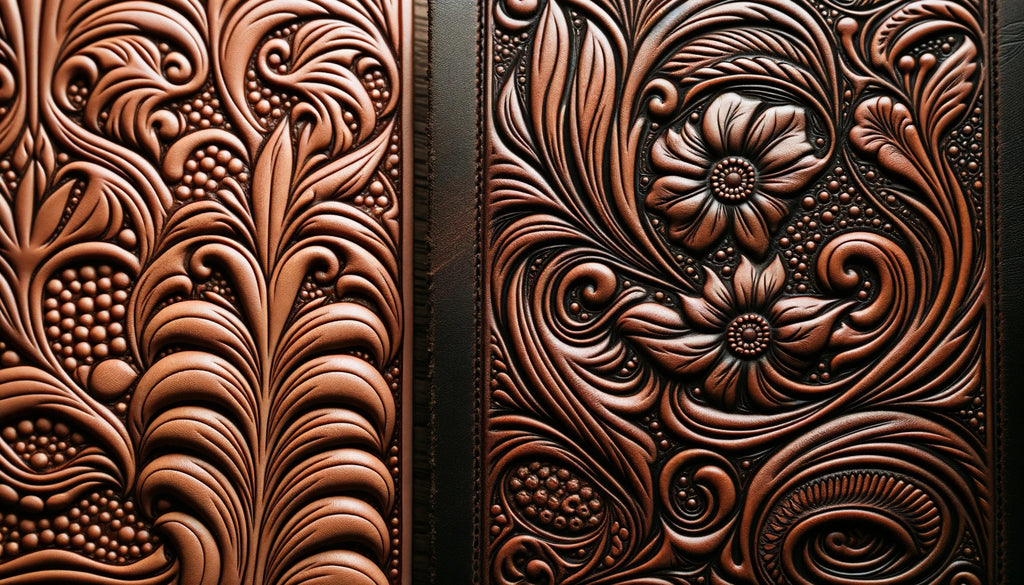
IV. Choosing Between Embossing and Engraving
When it comes to leatherwork, the choice between embossing and engraving can be a pivotal one. Both techniques offer unique aesthetics and functionalities, but which one aligns with your specific needs? Let's delve deeper.
1. Factors to Consider
Before making a decision, it's essential to weigh several considerations:
Purpose and Desired Outcome: What's the end goal? If you're aiming for a raised pattern that adds texture to the leather, embossing might be the way to go. However, if you're looking for intricate designs that are etched into the material, engraving could be your best bet.
Budget Constraints: While both methods have their cost implications, engraving, especially laser engraving, might be on the pricier side due to the equipment and precision involved. Embossing, on the other hand, might be more budget-friendly, especially for bulk projects.
Long-term Care and Maintenance: Engraved designs tend to be more resilient against wear and tear due to their recessed nature. Embossed patterns, while elegant, might require more care to maintain their raised appearance over time.
Quantity and Scale of the Project: If you're working on a large-scale project, such as producing a line of leather goods for sale, consider the time and resources each method demands. Embossing might be quicker, especially for bulk orders, while engraving could be more time-consuming but offers unparalleled detail.
2. Expert Recommendations
Having been in the leather industry for a while, I've seen the transformative power of both embossing and engraving. Here are some insights:
When to Opt for Embossing: If you're looking for a tactile experience where the design is raised from the leather surface, embossing is a fantastic choice. It's especially popular for items like business cards, book covers, and certain fashion accessories. The technique imparts a luxurious feel, making the product stand out.
Situations Where Engraving is More Suitable: If precision, detail, and longevity are at the forefront of your requirements, engraving is the way to go. Perfect for intricate designs, personalization, or when you want the artwork to be a permanent fixture on the leather, engraving offers depth and clarity that's hard to match.
Whether you choose embossing or engraving largely depends on the project's nature and your personal or brand preferences. Both methods have their merits, and understanding their nuances can help you make an informed choice that you'll be satisfied with for years to come. Remember, the beauty of leather lies in its ability to tell a story, and with the right technique, you can make that story truly captivating.
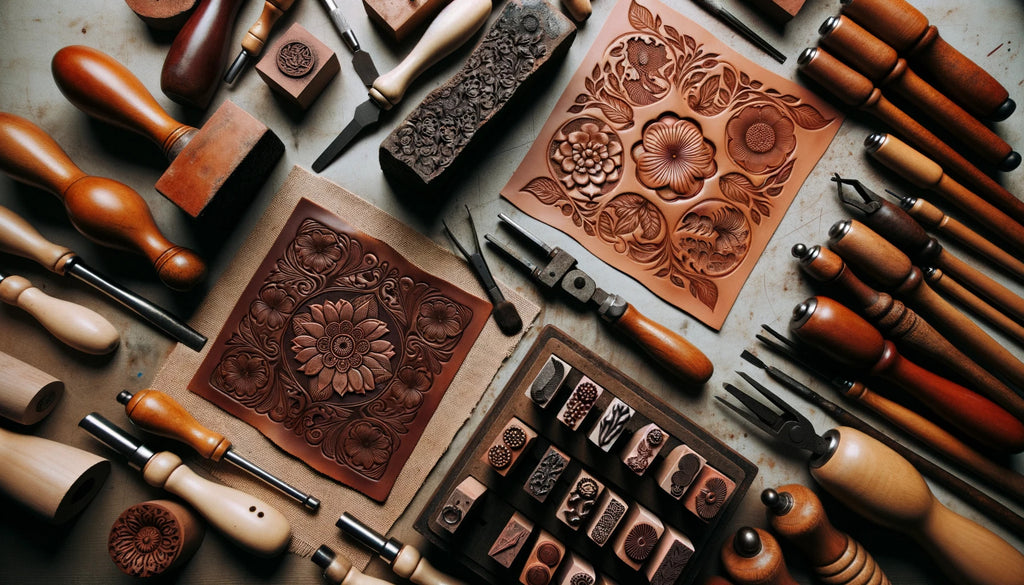
V. How to Care for Embossed or Engraved Leather?
When it comes to leather, whether it's a cherished handbag or a prized pair of shoes, proper care can significantly extend its life. I've delved deep into the nuances of leather care, especially when it comes to embossed and engraved leather. Here's what I've learned:
1. Maintenance Tips for Embossed Leather
Embossed leather has its unique charm, with raised designs that give it a distinctive texture. But how do you ensure that this texture remains as pristine as the day you bought it?
Cleaning and Conditioning:
Firstly, regular cleaning is essential. Use a soft, damp cloth to wipe away any surface dirt. For deeper cleaning, opt for a leather cleaner specifically designed for embossed leather. After cleaning, it's crucial to condition the leather. Conditioning not only restores moisture but also ensures that the embossed design remains prominent. I recommend using a leather conditioner that's light and non-greasy to avoid any residue buildup.
Storing to Prevent Wear:
Storage plays a pivotal role in maintaining the beauty of embossed leather. Always store your leather items in a cool, dry place. If it's a bag or footwear, consider using a padded insert or shoe tree to maintain its shape. Avoid stacking items on top of embossed leather products, as this can flatten the design over time.
2. Preservation Techniques for Engraved Leather
Engraved leather, with its intricate designs etched into the surface, requires a different approach. The carved designs, while beautiful, can be susceptible to wear if not cared for properly.
Protecting Against Moisture and Sunlight:
Moisture and sunlight are engraved leather's arch-nemeses. Prolonged exposure can cause the leather to dry out, leading to cracks, especially around the engraved areas. Always store engraved leather items away from direct sunlight. If they get wet, allow them to dry naturally, away from heat sources. For added protection, consider using a leather protector spray that offers a barrier against moisture and UV rays.
Ensuring the Engraved Design Remains Intact:
The beauty of engraved leather lies in its detailed designs. To ensure these designs remain clear and intact, avoid rubbing or scratching the engraved areas. When cleaning, use a soft brush to gently remove dirt from the engraved sections. If the design starts to fade, consult a leather specialist. They might be able to refresh the engraving, bringing it back to its original glory.
Whether you're a fan of the raised designs of embossed leather or the intricate etchings of engraved leather, proper care is the key to longevity. With the right techniques and a bit of diligence, your leather treasures will remain as stunning as ever. Remember, leather is not just a material; it's an investment in style and elegance. Treat it well, and it will undoubtedly reciprocate with years of beauty and service.
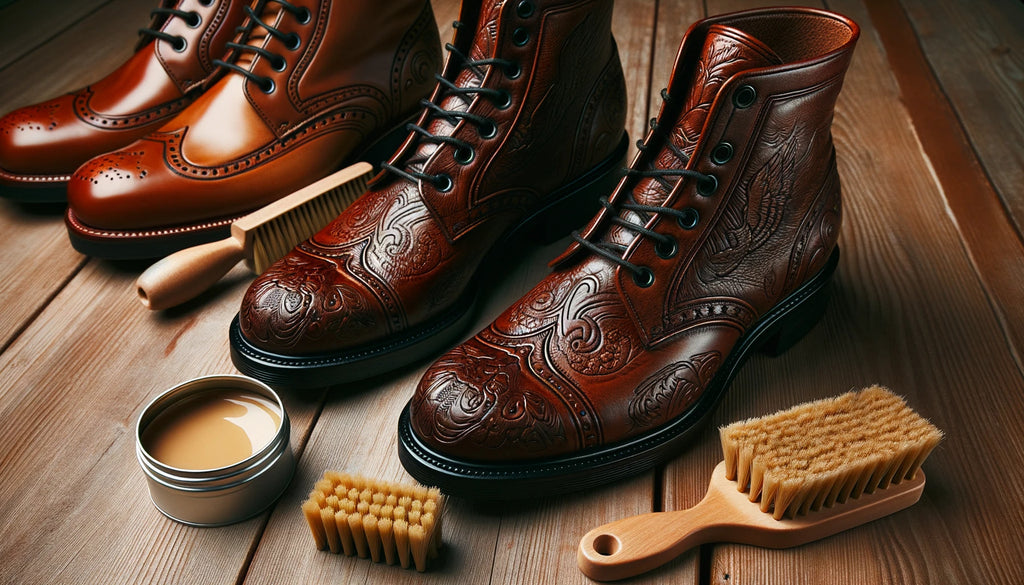
Conclusion
Leather, with its timeless allure and unmatched elegance, is more than just a material—it's a testament to style, durability, and craftsmanship. Whether embossed with intricate patterns or engraved with detailed designs, each piece tells a story of artistry and care.
However, like any treasured possession, it demands our attention and respect. By investing a little time in its maintenance, we not only preserve its beauty but also extend its life, ensuring that it continues to add charm to our lives.
So, as we cherish the moments and memories associated with our leather items, let's also commit to caring for them, ensuring they remain our companions for years to come. After all, in the world of fashion and functionality, leather stands unparalleled, and its care is a tribute to its legacy.
Frequently Asked Questions (FAQs)
What is the primary difference between embossing and engraving on leather?
Embossing raises the leather's surface to create a design, while engraving involves carving or etching into the leather.
Is one method more durable than the other?
Both methods can offer durability, but engraved designs, being recessed, are less exposed to external wear and might last longer without fading.
Can I have both embossed and engraved designs on the same leather product?
Yes, it's possible to combine both techniques, but careful planning is essential to ensure the designs complement each other.
Which method is more cost-effective?
The cost can vary based on design complexity, leather quality, and the craftsman's expertise. Generally, embossing might be less expensive, but it's best to get quotes for both.
How do I clean and maintain my embossed or engraved leather items?
Use a soft cloth for regular cleaning. For deeper cleaning, opt for leather-specific cleaners. Conditioning is crucial for maintaining moisture and the design's prominence.
Is there a risk of the leather getting damaged during the embossing or engraving process?
With experienced craftsmen and the right tools, the risk is minimal. However, it's essential to ensure the leather's thickness and quality are suitable for the chosen method.
Which method is more time-consuming?
Engraving, especially intricate designs, might take longer than embossing. However, the exact time can vary based on the design and the craftsman's expertise.
Can all types of leather be embossed or engraved?
Most leathers can undergo both processes, but results can vary based on the leather's thickness, quality, and type.
Do embossed or engraved designs fade over time?
With proper care, both designs can last a long time. However, embossed designs, being raised, might wear down faster if exposed to frequent friction.
If my engraved design fades, can it be refreshed?
Yes, a leather specialist might be able to refresh the engraving, but it's essential to consult with an expert to ensure the best results.
📫 Related Blog Posts:
📌 How to Get Water Stains Out of Leather? Erase Water Marks Effortlessly
📌 Leather Care Essentials: Best Oils and Maintenance Practices
📌 How to Get Smell Out of Leather? Say Goodbye to Leather Odors
📌 How to Restore Leather? A Complete Guide to Revive Your Leather
📌 How to Darken Leather? From Faded to Fabulous
📌 How to Sew Leather? Leather Sewing Unleashed
📌 How To Emboss Leather? Master the Art of Leather Embossing
📌 How to Fix Cat Scratches on Leather?
1 comment





I have a poem I would like to have engraved on a piece of my tanned deer hide.
Leave a comment